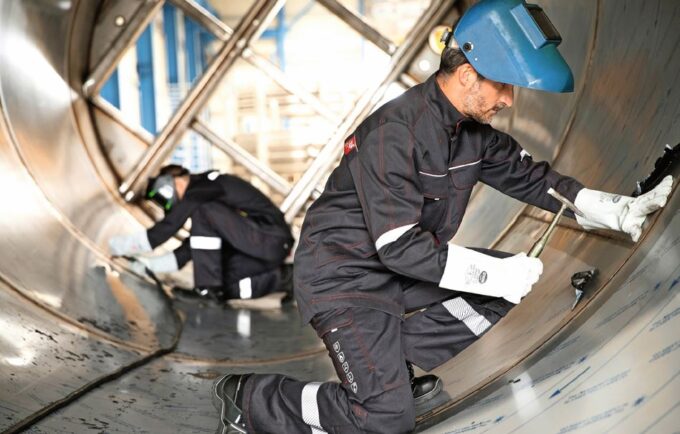PPE: Regular care and maintenance
Even the highest quality protective clothing will become soiled and worn over time. However, washing, care or mending must not be at the expense of the protective effect, clear specifications are required.
The personal protective equipment (PPE) required at a workplace or for an activity must not only be available. It must also be ready for use and reasonable, i.e. functional and in a well-maintained and hygienically acceptable condition. But with most PPE components, care and cleaning is less trivial than with private clothing, and mending or repairing them also requires specialist knowledge. Mistakes whose consequences are "only" annoying with private clothing, such as a sweater that has shrunk due to being washed too hot, can be life-threatening with incorrectly treated protective equipment.
When incorrect cleaning destroys a protective function
The demands on the cleanliness of work and protective clothing naturally differ depending on the industry. In agriculture or construction, the requirements are different from those in the office or laboratory. But in any professional environment, clean protective clothing increases wearer acceptance and well-being. PPE worn on the body in particular should meet minimum hygiene requirements. However, the fact that PPE has to be cleaned of dirt and sweat is not only due to hygienic reasons. Cleanliness is often closely linked to safety or health aspects. For example, contamination with oils or greases increases the flammability of textile fabrics, and soiled high-visibility clothing can only provide limited reflection.
Protective clothing well-intentioned, but carelessly putting it in a washing machine is usually not a good idea, because:
- Due to an incorrectly selected detergent or washing process, flame-retardant impregnations can be lost, reflective stripes can become detached or the retroreflection and fluorescence can diminish.
- Adhering soiling caused by hazardous substances must be removed effectively and must not be distributed to other textiles.
- PPE contaminated with infectious bio-substances requires special disinfecting washing procedures.
- Detergent residues can change the electrostatic properties of PPE, also dissipative fibers could be washed out.
- Cut protection layers in PPE for working with chainsaws can slip.

The specifications of the PSA manufacturer are decisive
When purchasing protective equipment, the purchaser receives written instructions. In these instructions for use, the manufacturer informs the PPE user about everything he or she needs to know about storage, cleaning, care, and so on. These include information on storage - usually dry, frost-free and protected from the sun - as well as specific instructions on cleaning and care depending on the protective function. For example, protective clothing for work areas with a risk of infection may specify which agents are permitted in disinfecting washing processes. In the case of high-visibility clothing, it is crucial that color fastness, retroreflection and fluorescence are still given; here, the manufacturer specifies a maximum number of care cycles. For all PPE components, only proper care, reprocessing and storage of PPE in accordance with the manufacturer's specifications will ensure the protective function.
Any mending and repair work may also only be carried out in accordance with the manufacturer's instructions. For example, in the case of welding protective clothing and PPE against fire and flames, the sewing thread or bobbin thread must also be made of a flame-retardant material. Such PPE must not be repaired by the sewing shop on the corner or by a family member who is a sewing enthusiast.
Careful control protects health and can save lives
Maintenance and control of protective equipment? This may sound exaggerated when you think of earplugs or disposable gloves. But PPE also includes means of rope protection and fall protection or equipment for height rescue, where the need for careful inspection and maintenance procedures needs no discussion. Even in the case of full-body chemical suits or heavy breathing protection with compressed air, it is obvious that inspection, care and, if necessary, professional repair are highly relevant to safety. Basically, protective equipment should be critically checked at the latest after a cleaning procedure, e.g.:
- Are there signs of aging, wear and tear such as cracks, holes, scuffed areas or cracked seams on heavily loaded components?
- Are all zippers, buttons, loops, pockets, etc. still intact and functional?
- In chemical protective clothing, are the fabrics and especially the seams still tight and provide protection against the penetration of liquids?
- In the case of electricians' protective equipment, are the electrically conductive parts such as zippers or buttons still safely covered?
- Is re-processing of protective properties necessary, e.g. re-impregnation with flame retardant substances?
It should not be forgotten that non-textile materials are also subject to aging processes. Metals corrode and plastics will soften or become brittle and stiff over time, depending on the material and environmental influences. For many PPE components, the manufacturer therefore specifies a permissible service life.
Obligations for employers - but also for employees
The above examples make it clear that cleaning, care, inspection and, if necessary, repair of PPE must be organized within a company. Who takes over which of these tasks for which PPE - in-house or via external service providers - should be clearly regulated. Where this is not done, employees could be tempted to take dirty or damaged protective equipment home with them, possibly spreading hazardous substances to their families and private surroundings.
The following principles must be observed in the in-house regulations for the maintenance of PPE:
- The company must take organizational steps to ensure that PPE is in perfect condition throughout its service life.
- Not only the PPE itself, but also the cleaning, care, inspection, repair, etc. is free of charge for the employee. The employer may not pass on these costs to the PPE users.
- The employer should instruct its employees on the care, cleaning, storage, etc. of PPE and provide the necessary resources and facilities.
- Whether cleaning or inspecting, any effort to maintain PPE is part of paid work time and is not a task for break times or weekends.
- Whenever cleaning, inspection and maintenance of a PPE component require special knowledge, the employer must appoint a suitable person or delegate the care, reprocessing, repair etc. to an external service provider. This could be, for example, a rental service that, in addition to washing and maintaining the PPE, also checks, repairs and maintains it.
- Protective equipment
- ed or exchanged.
Employees must follow the manufacturer's instructions on limits of use, wear or storage, etc. when using their protective equipment. For example, hard hats should not be stored unnecessarily in the blazing sun. Damaged PPE that is no longer intended for use should be disposed of consistently and should not be left lying around or even taken home by employees for private use. After all, anyone who relies on a supposed protective function is taking higher risks, and with PPE, compromises and carelessness can have fatal consequences.









